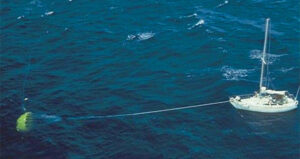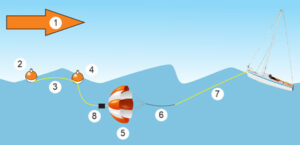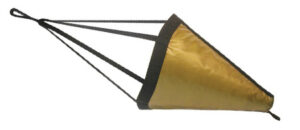Viral anchor is one of the devices on a boat that is wise to have, but we hope we never have to use it.
It is commonly believed that a storm anchor is only useful for those sailing across the ocean, but this is not true. A storm anchor is also very useful when sailing in inland waters.
What is a storm anchor?

Storm anchor in the shape of a parachute

Storm anchor – parts
A storm anchor is a device that does not anchor the boat but helps stabilize it. It is in the shape of a smaller parachute or conical bag, which creates significant drag in the water. There are two types. One is intended to be attached to the bow of the boat, it is in the shape of a parachute and has additional weight and two floats. It is attached to the bow of the boat with one rope. The English name for it is “sea anchor.” The second type of anchor is intended for attaching to the stern. It is in the shape of a conical bag and is usually attached with two ropes. The English name for it is “drogue.”
How and when to use a storm anchor
Storm anchors are intended for use in extreme conditions. Their job is to:
- slow down the boat,
- keep it as stationary as possible,
- prevent it from turning sideways into the wind, and
- allow changes in the direction of the boat.
Storm anchor in the shape of a parachute
The storm anchor in the shape of a parachute is designed to keep the bow of the boat into the wind and reduce the speed of drift. It is attached to one of the cleats on the bow. We use it when we lose the boat’s maneuverability (engine failure, torn sails, etc.). A boat without propulsion will always turn sideways relative to the wind direction in strong winds and waves. Due to the large surface of the side, it will quickly drift in the direction of the wind. If we are sailing in inland waters, there is a danger of being carried towards the shore. By reducing the speed of sideways drift, we buy valuable time for proper action, engine repairs, or waiting for rescuers. Another danger is the waves. When we are turned sideways, they will rock us strongly and easily capsize the boat. The storm anchor will keep the bow of the boat turned towards the wind. The boat will be more stable, staying on board will be safer, and the crew will be less exhausted. The storm anchor in the shape of a parachute reduces the speed of the boat to 0-2 knots.
Parts of a storm anchor:
-
- wind direction
- floating buoy for raising the anchor
- floating rope
- floating buoy or floating bag of the storm anchor for raising the anchor
- storm anchor in the shape of a parachute
- weight or chain
- rope for attaching to the boat
- weight
The storm anchor in the shape of a parachute can also be used in an emergency when sailing in high waves. In this case, we attach it to the stern of the boat. It will reduce speed when sailing down the wave and prevent the loss of the rudder.
The use of a storm anchor is also encountered in non-dangerous situations. Fishermen use it to reduce the drift of the boat due to the wind. They often attach it to the side of the boat. The boat is still turned sideways into the wind and waves, but only the speed of the drift is reduced. In this way, they can set up several fishing rods along the entire length of the boat.
Storm anchor in the shape of a cone
Storm anchor in the shape of a cone
The storm anchor in the shape of a cone has slightly different properties. Usually, they are placed on the stern of the boat and are mainly used to reduce the speed of the boat when sailing down a wave (reduces speed to 4-6 knots). Due to the increased drag, they hold the stern of the boat and reduce the possibility of the stern overtaking the bow when sailing down the wave. It also reduces forces on the rudder, thus lowering the chance of losing control. This anchor is useful whenever we still have control over the boat, but stability is difficult to ensure. Such a situation is also common with motorboats, when the main engine fails, and we are sailing with a backup engine that does not have enough power for reliable steering. The conical storm anchor will help maintain the course of the boat. Since this anchor is usually attached to the stern with two ropes, it can also be used as a backup steering system. By shortening the rope on one side of the stern, the drag on that side of the boat will increase, and the boat will start to change direction.
Mandatory
When purchasing a storm anchor, we must consider the size, shape, and weight of our boat, as well as the weather conditions in which we expect the storm anchor to be effective. A good consultation with an expert will not be a waste.
Tip
The storm anchor is one of the devices on the boat that should be trained before actual use. It can be compared to using a life jacket, rescuing a person from the sea, or using distress rockets or flares. If we do not train to use it, the likelihood of correctly using the device when we urgently need it will be very low.
Source: eNavtika.si


